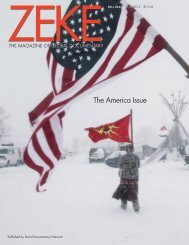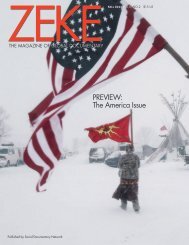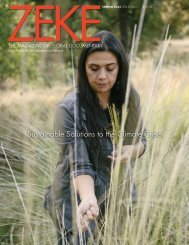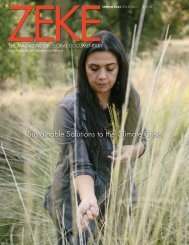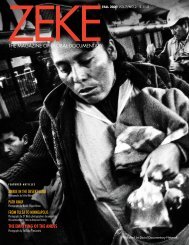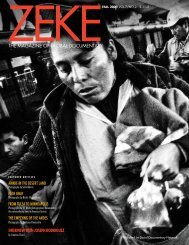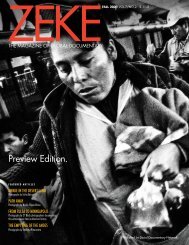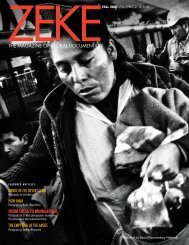ZEKE Fall 2019
Contents includes: "Youth of Belfast" by Toby Binder, and "Delta Hill Riders" by Rory Doyle, winners of ZEKE Award for Documentary Photography "Rising Tides" with photographs by Sean Gallagher, Lauren Owens Lambert, and Michael O. Snyder "Out of the Shadows: Shamed Teen Mothers of Rwanda" by Carol Allen Storey Interview with Lekgetho Makola, Head of Market Photo Workshop, South Africa, by Caterina Clerici "Why Good Pictures of Bad Things Matter" by Glenn Ruga Book Reviews and more...
Contents includes:
"Youth of Belfast" by Toby Binder, and "Delta Hill Riders" by Rory Doyle, winners of ZEKE Award for Documentary Photography
"Rising Tides" with photographs by Sean Gallagher, Lauren Owens Lambert, and Michael O. Snyder
"Out of the Shadows: Shamed Teen Mothers of Rwanda" by Carol Allen Storey
Interview with Lekgetho Makola, Head of Market Photo Workshop, South Africa, by Caterina Clerici
"Why Good Pictures of Bad Things Matter" by Glenn Ruga
Book Reviews and more...
- No tags were found...
You also want an ePaper? Increase the reach of your titles
YUMPU automatically turns print PDFs into web optimized ePapers that Google loves.
BOOK<br />
REVIEWS<br />
NO PLACE ON EARTH<br />
Photographs by Patrick Brown,<br />
text by Jason Motlagh and<br />
Matthew Smith<br />
FotoEvidence Press, <strong>2019</strong><br />
208 pages | $60<br />
In August 2017,<br />
Myanmar’s army<br />
attacked hundreds<br />
of thousands<br />
of ethnic Rohingya<br />
Muslims in northern<br />
Rakhine State,<br />
killing civilians,<br />
raping women and<br />
burning villages. Hundreds of thousands<br />
fled across the Naf River to neighboring<br />
Bangladesh. The violence against the<br />
Rohingya had been percolating since<br />
the 1970s in one of the longest planned<br />
genocides in human history.<br />
After the Bosnian and Rwandan genocides<br />
of the 1990s, the world proclaimed<br />
“never again.” Once again, genocide has<br />
been perpetrated on civilians, but this time<br />
there has been no Truth and Reconciliation<br />
Commission nor International Criminal<br />
Court prosecutions. None of the perpetrators<br />
have been held accountable. The<br />
Rohingya lost their citizenship in Myanmar<br />
and have lived in protracted statelessness<br />
and displacement, living in internment<br />
camps in Myanmar or sprawling camp settlements<br />
across the border in Cox’s Bazar<br />
in Bangladesh, denser than Manhattan.<br />
Myanmar State Counsellor Aung San Suu<br />
Kyi’s administration oversaw the genocide<br />
and has done nothing to help the survivors.<br />
But this doesn’t mean that the Rohingya<br />
don’t have a voice.<br />
Photographer Patrick Brown was living<br />
in Thailand in 2017 and was able to<br />
immediately travel to Bangladesh as the<br />
first survivors arrived there. This book is a<br />
powerful account of what he saw, serving<br />
as important evidence and required reading<br />
for policymakers who have turned a<br />
blind eye to this war crime.<br />
“Genocide is about the survivors—the<br />
living. The survivors in these pages bear<br />
witness to the horror ..they are a testament<br />
of the enduring will to live and the<br />
resilience of life” says Matthew Smith,<br />
Co-founder and Chief Executive Officer of<br />
Fortify Rights, in a moving opening essay.<br />
Many of the photographs in No Place<br />
on Earth are dark—both in tone and in<br />
subject matter. As one survivor, Nazmal<br />
Islam said “we don’t have any light in<br />
our life, everything is dark.” The opening<br />
pages depict ominous and thick monsoon<br />
clouds over dark seas. These are followed<br />
by spreads of buried shrouds, women in<br />
veils, brightly colored parasols against<br />
the night sky, candlelight gatherings in the<br />
camps and moonlight shadows. Despite<br />
the grimness, Patrick’s photos still manage<br />
to find beauty. (One criticism: the captions<br />
carrying vital background information<br />
come pages after the photographs, causing<br />
the reader to have to flip back and<br />
forth to get the context.)<br />
Telling the stark truth of the Rohingya<br />
survivors today, Brown includes devastating<br />
children’s drawings of the violence,<br />
blood, fires, and helicopters flying over<br />
their villages. Veteran human rights<br />
investigator, Peter Bouckhaert, writes how<br />
the children will forever be afflicted by the<br />
severity of their trauma. “We confront the<br />
depths of human depravity towards fellow<br />
human beings. What these children have<br />
witnessed will leave them forever haunted.<br />
But it should haunt us as well.”<br />
Then, there are the riveting testimonies<br />
and stories of survivors that each read<br />
like a thriller, accompanied by Brown’s<br />
stunning portraits. Rajuma Begum from<br />
the village of Tula Toli recounts how she<br />
was separated from her husband (later<br />
reunited), her son thrown into a fire, how<br />
she was raped, but managed to escape.<br />
These harrowing and very detailed<br />
accounts were collected by Jason Motlagh,<br />
writer and director at Blackbeard Media.<br />
The darkness lifts a bit and the images<br />
turn to skies awash with beautiful sunsets.<br />
A peaceful portrait of a baby resting on his<br />
father’s chest as they recline in the camp.<br />
Children play on a makeshift ferris wheel<br />
celebrating Eid after Ramadan.<br />
Unexpectedly, Brown includes full-page<br />
portraits of machetes, sickles, axes, and<br />
hoes--the handmade tools of the Rohingya<br />
that were used to farm their lands and harvest<br />
their gardens that were taken from them<br />
by the military and wielded against them as<br />
weapons of war. Today, these tools resume<br />
their original purpose: helping clear trees,<br />
build bamboo shacks, till small vegetable<br />
plots and rice paddies and bury the dead.<br />
Returning to Myanmar is not an option<br />
for Rohingya unless they renounce their ethnicity.<br />
As one survivor says, “We have no<br />
place on earth where we can find peace.”<br />
But Brown says, “Photography forces<br />
a confrontation, a reckoning by putting a<br />
face to the cruelty. These were witnesses<br />
and they live on.” It is also an attempt to<br />
show that the oppressors haven’t won.<br />
—Barbara Ayotte<br />
54 / <strong>ZEKE</strong> FALL <strong>2019</strong>









